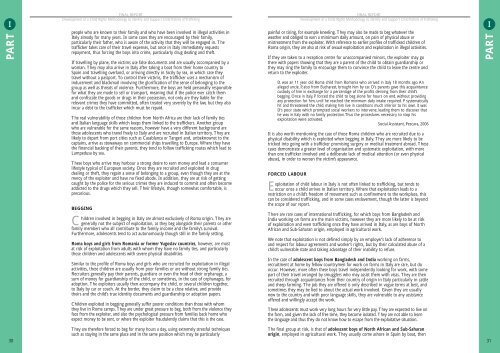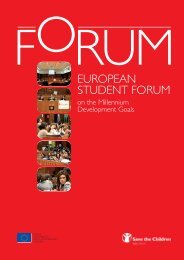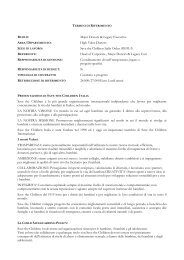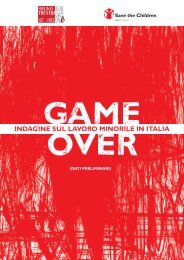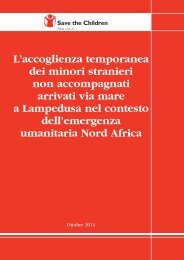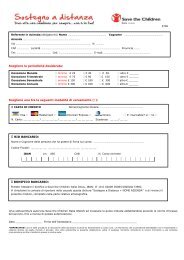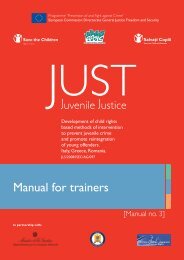FINAL REPORT - Save the Children Italia Onlus
FINAL REPORT - Save the Children Italia Onlus
FINAL REPORT - Save the Children Italia Onlus
You also want an ePaper? Increase the reach of your titles
YUMPU automatically turns print PDFs into web optimized ePapers that Google loves.
IPART<strong>FINAL</strong> <strong>REPORT</strong>Development of a Child Rights Methodology to Identify and Support Child Victims of Traffickingpeople who are known to <strong>the</strong>ir family and who have been involved in illegal activities inItaly already for many years. In some cases <strong>the</strong>y are encouraged by <strong>the</strong>ir family,particularly <strong>the</strong>ir fa<strong>the</strong>r, who is aware of <strong>the</strong> activity that <strong>the</strong>y will be engaged in. Thetrafficker takes care of <strong>the</strong>ir travel expenses, but once in Italy immediately requestsrepayment, thus forcing <strong>the</strong> boys into crime, particularly drug dealing and <strong>the</strong>ft.If travelling by plane, <strong>the</strong> victims use false documents and are usually accompanied by awoman. They may also arrive in Italy after taking a boat from <strong>the</strong>ir home country toSpain and travelling overland, or arriving directly in Sicily by sea, in which case <strong>the</strong>ytravel without a passport. To control <strong>the</strong>ir victims, <strong>the</strong> trafficker uses a mechanism ofinducement and blackmail involving <strong>the</strong> glorification of <strong>the</strong> sense of belonging to <strong>the</strong>group as well as threats of violence. Fur<strong>the</strong>rmore, <strong>the</strong> boys are held personally responsiblefor what <strong>the</strong>y are made to sell or transport, meaning that if <strong>the</strong> police ever catch <strong>the</strong>mand confiscate <strong>the</strong> goods or drugs in <strong>the</strong>ir possession, not only are <strong>the</strong>y liable for <strong>the</strong>relevant crimes <strong>the</strong>y have committed, often treated very severely by <strong>the</strong> law, but <strong>the</strong>y alsoincur a debt to <strong>the</strong> trafficker which must be repaid.The real vulnerability of those children from North Africa are <strong>the</strong>ir lack of family tiesand <strong>Italia</strong>n language skills which keeps <strong>the</strong>m linked to <strong>the</strong> traffickers. Ano<strong>the</strong>r groupwho are vulnerable for <strong>the</strong> same reasons, however have a very different background arethose adolescents who travel freely to Italy and are recruited in <strong>Italia</strong>n territory. They arelikely to depart from port cities such as Casablanca or Tangeri and, unbeknownst to <strong>the</strong>captains, arrive as stowaways on commercial ships travelling to Europe. Where <strong>the</strong>y have<strong>the</strong> financial backing of <strong>the</strong>ir parents, <strong>the</strong>y tend to follow trafficking routes which lead toLampedusa by sea.These boys who arrive may harbour a strong desire to earn money and lead a consumerlifestyle typical of European society. Once <strong>the</strong>y are recruited and exploited in drugdealing or <strong>the</strong>ft, <strong>the</strong>y regain a sense of belonging to a group, even though <strong>the</strong>y are at <strong>the</strong>mercy of <strong>the</strong> exploiter and have no fixed abode. In addition, <strong>the</strong>y are at risk of gettingcaught by <strong>the</strong> police for <strong>the</strong> serious crimes <strong>the</strong>y are induced to commit and often becomeaddicted to <strong>the</strong> drugs which <strong>the</strong>y sell. Their lifestyle, though somewhat comfortable, isprecarious.BEGGING<strong>Children</strong> involved in begging in Italy are almost exclusively of Roma origin. They aregenerally not <strong>the</strong> subject of exploitation, as <strong>the</strong>y beg alongside <strong>the</strong>ir parents or o<strong>the</strong>rfamily members who all contribute to <strong>the</strong> family income and <strong>the</strong> family’s survival.Fur<strong>the</strong>rmore, adolescents tend to act autonomously though still in <strong>the</strong> family setting.Roma boys and girls from Romania or former Yugoslav countries, however, are mostat risk of exploitation from adults with whom <strong>the</strong>y have no family ties, and particularlythose children and adolescents with severe physical disabilities.Similar to <strong>the</strong> profile of Roma boys and girls who are recruited for exploitation in illegalactivities, <strong>the</strong>se children are usually from poor families or are without strong family ties.Recruiters generally pay <strong>the</strong>ir parents, guardians or even <strong>the</strong> head of <strong>the</strong>ir orphanage, asum of money for guardianship of <strong>the</strong> child, or sometimes, in <strong>the</strong> case of orphanages, foradoption. The exploiters usually <strong>the</strong>n accompany <strong>the</strong> child, or several children toge<strong>the</strong>r,to Italy by car or coach. At <strong>the</strong> border, <strong>the</strong>y claim to be a close relative, and provide<strong>the</strong>irs and <strong>the</strong> child’s true identity documents and guardianship or adoption papers.<strong>Children</strong> exploited in begging generally suffer poorer conditions than those with whom<strong>the</strong>y live in Roma camps. They are under great pressure to beg, both from <strong>the</strong> violence <strong>the</strong>yface from <strong>the</strong> exploiter, and also <strong>the</strong> psychological pressure from families back home whoexpect money to be sent, or where <strong>the</strong> exploiter fraudulently claims that this is <strong>the</strong> case.<strong>FINAL</strong> <strong>REPORT</strong>Development of a Child Rights Methodology to Identify and Support Child Victims of Traffickingpainful or tiring, for example kneeling. They may also be made to beg whatever <strong>the</strong>wea<strong>the</strong>r and obliged to earn a minimum daily amount, on pain of physical abuse ormistreatment from <strong>the</strong> exploiter. With reference to earlier profiles of trafficked children ofRoma origin, <strong>the</strong>y are also at risk of sexual exploitation and exploitation in illegal activities.If <strong>the</strong>y are taken to a reception centre for unaccompanied minors, <strong>the</strong> exploiter may go<strong>the</strong>re with papers showing that <strong>the</strong>y are a parent of <strong>the</strong> child to obtain guardianship or<strong>the</strong>y may ring <strong>the</strong> family to encourage <strong>the</strong>m to convince <strong>the</strong> child to leave <strong>the</strong> centre andreturn to <strong>the</strong> exploiter.D. was an 11 year old Roma child from Romania who arrived in Italy 18 months ago. Analleged uncle, P, also from Bucharest, brought him by car. D’s parents gave this acquaintancecustody of him in exchange for a percentage of <strong>the</strong> profits deriving from <strong>the</strong>ir child’sbegging. Once in Italy, P forced <strong>the</strong> child to beg alone for hours on end, without providingany protection for him, until he reached <strong>the</strong> minimum daily intake required. P systematicallyhit and threatened <strong>the</strong> child, making him live in conditions much inferior to his own. It wasD’s poor state which prompted social workers to intervene, leading <strong>the</strong>m to discover tha<strong>the</strong> was in Italy with no family protection.Thus <strong>the</strong> procedures necessary to stop hisexploitation were activated.Social Assistant, Pescara, 2006It is also worth mentioning <strong>the</strong> case of those Roma children who are recruited due to aphysical disability which is exploited when begging in Italy. They are more likely to betricked into going with a trafficker promising surgery or medical treatment abroad. Thesecases demonstrate a greater level of organisation and systematic exploitation, with morethan one trafficker involved and a deliberate lack of medical attention (or even physicalabuse), in order to worsen <strong>the</strong> victim’s appearance.FORCED LABOURExploitation of child labour in Italy is not often linked to trafficking, but tends tooccur once a child arrives in <strong>Italia</strong>n territory. Where that exploitation leads to arestriction on a child’s freedom of movement such as confinement to <strong>the</strong> workplace, thiscan be considered trafficking, and in some cases enslavement, though <strong>the</strong> latter is beyond<strong>the</strong> scope of our report.There are rare cases of international trafficking, for which boys from Bangladesh andIndia working on farms are <strong>the</strong> main victims, however <strong>the</strong>y are more likely to be at riskof exploitation and even trafficking once <strong>the</strong>y have arrived in Italy, as are boys of NorthAfrican and Sub-Saharan origin, employed in agricultural work.We note that exploitation is not defined simply by an employer’s lack of adherence toand respect for labour agreements and worker’s rights, but by <strong>the</strong>ir calculated abuse of achild’s vulnerable state and taking advantage of <strong>the</strong>ir inability to refuse.In <strong>the</strong> case of adolescent boys from Bangladesh and India working on farms,recruitment at home by fellow countrymen for work on farms in Italy are rare, but dooccur. However, more often <strong>the</strong>se boys travel independently looking for work, with somepart of <strong>the</strong>ir travel arranged by smugglers who may assist <strong>the</strong>m with visas. They are <strong>the</strong>nrecruited through acquaintances from <strong>the</strong>ir country of origin in Italy particularly in cattleand sheep farming. The job <strong>the</strong>y are offered is only described in vague terms at best, andsometimes <strong>the</strong>y may be lied to about <strong>the</strong> actual work involved. Given <strong>the</strong>y are usuallynew to <strong>the</strong> country and with poor language skills, <strong>the</strong>y are vulnerable to any assistanceoffered and willingly accept <strong>the</strong> work.These adolescents must work very long hours for very little pay. They are expected to live on<strong>the</strong> farm, and given <strong>the</strong> lack of free time, <strong>the</strong>y become isolated. They are not able to learn<strong>the</strong> language and thus <strong>the</strong>y do not know how to escape from <strong>the</strong> exploitative situation.IPART30They are <strong>the</strong>refore forced to beg for many hours a day, using extremely stressful techniquessuch as staying in <strong>the</strong> same place and in <strong>the</strong> same position which may be particularlyThe final group at risk, is that of adolescent boys of North African and Sub-Saharanorigin, employed in agricultural work. They usually come ashore in Spain by boat, <strong>the</strong>n31


